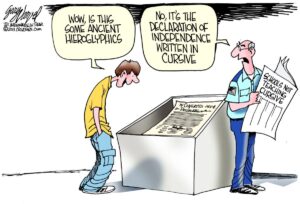The Death of Cursive
Older generations may be onto something when they bemoan the death of cursive writing.
By Corey Kendig
Recently, while scrolling the internet, I found the below comic:

As a member of Gen Z who cannot read cursive, I understand the sentiment. I, like many of my peers, possess little to no cursive literacy. Many, including myself initially, don’t see any problem with this form of illiteracy. Yet, after reading the comments below this comic, it’s clear that older generations may have stronger opinions on the issue of cursive not being taught in our schools than I do.
A Conspiracy?
The comments were filled with statements claiming that the American Left has a secret agenda that starts with eliminating cursive and ends with the total destruction of America’s fundamental rights. And while I am no fan of the Left, I truly do not think that their scheme would include the trivial removal of cursive from the education system. To clarify, I do not believe the average boomer, Gen Xer, or Millennial is the person to voice their frustration in the comment section of a Facebook meme. But, I do believe that this instance is a microcosm of a greater sentiment.
Unlearning Cursive
My grandmother who was an elementary school teacher has voiced her disagreement with the decision to stop teaching cursive writing. She has often told my mother how she thinks it’s just “downright awful,” and that my brother and I “don’t know how to write anymore” (thanks for the vote of confidence Mimi).
But to a certain degree, she has a point. My brother and I grew up in the 2010s when Common Core decided to cut cursive requirements from their curriculum. I learned how to write in cursive for a year and vividly remember being told that I would “only be allowed to write in cursive when I got to the fourth grade,” only for my fourth-grade teacher to tell me I could write however I pleased. Naturally, I switched back to what was comfortable. On the other hand, my younger brother never spent a single class period learning how to write in cursive.
Becoming Obsolete
Looking back on it, I never understood why I was taught cursive in the first place. Sure it had some benefits, like learning how to sign my name, but the general exploit was for the most part… useless. I am not the only one who thought this either; educators think so as well. Ten years ago in an interview with the Washington Post, Patricia Granada, principal at Eagle View Elementary in Fairfax County said this: “It’s seeing the writing on the wall. Cursive is increasingly becoming obsolete.”
Older conservatives, however, seem to want to fight against this movement to throw cursive in the dustbin of history. But why? As conservatives, it is our job to conserve (it’s even in the name). We are hesitant to embrace modernity for modernity’s sake. Instead, we heed the wisdom of our forefathers and rely on tradition. As IFF’s Dr. Paul Kengor would say, “Conservatism is about conserving time-tested traditions because they work.” Cursive is one of these traditions.
A Lost Art
Older conservatives may be onto something when they bemoan the departure of cursive writing in schools. Studies have shown that cursive has small benefits in retention, fine motor skills, and leads to using more of your brain when writing. And despite not being as fast as typing, educators note that once cursive is mastered, those who write it are faster than those who handwrite. Not to mention that cursive teaches art just as much as penmanship. The flows, loops, and gliding of cursive inspire beauty in the small things such as writing.
Despite these benefits, cursive as a whole has been tossed aside. I can only assume that, as studies are done on my generation, they will see small to moderate deficiencies in the areas I have listed above. As a student of history, it will be truly tragic when future historians lose the ability to read letters and notes due to not knowing how to decipher cursive writing. But perhaps there is still hope.
A Return?
While Principal Granada may have felt the tides turning in 2013. But the art form may be making a comeback for Generation Alpha. In 2016, cursive requirements hit their lowest when only 14 states required its teaching, but in 2023 that number jumped back to 21. A possible reason for this is the concern about AI being able to do work for students. Currently, AI can not read or write in cursive, so some teachers view the artistic writing form as a way to ensure that students are both reading and writing for themselves instead of having technology do it for them.
In a comment for Education Week, one educator stated, “Particularly in an age when AI gives such easy access to plagiarism, the ability to write one’s own thoughts down in handwriting (sans computer technology) seems pretty important. I see more teachers going back to handwritten, in-class assessments for this very reason. The ability to write fluently on paper will never be obsolete.”
Moving Forward
Alas, this comeback may be too late for me and my classmates. Cursive has skipped an entire generation of children. I do not spend countless hours dreading my inability to write and read cursive. Yet I do believe my generation has been robbed of the beauty and benefits of cursive writing. Even with the upward trend for cursive writing, I would strongly encourage those with young ones at home to try to teach them cursive on their own. This way, we can ensure cursive lives on for future generations regardless of the education standards.
 About the Author
About the Author
Corey Kendig is a senior history and political science major from Marietta, Pennsylvania, and a content editor for Checkpoint News. He is the Executive Citations Editor at the Grove City Journal of Law & Public Policy and a member of the American Enterprise Institute Collegiate Network.
Corey writes as a freelance journalist for several publications. He has written for notable organizations such as The Federalist, College Fix, and the James G. Martin Institute. He has interned at the United States House of Representatives and the Pennsylvania Family Institute. He is a Marketing Fellow with the Institute for Faith & Freedom.
Disclaimer: The views and opinions expressed are those of the writer alone and do not necessarily reflect the official policy or position of Grove City College, the Institute for Faith and Freedom, or their affiliates.
